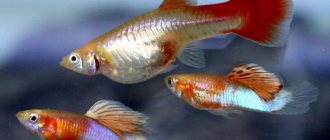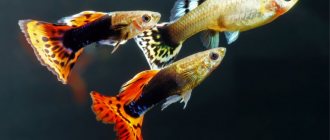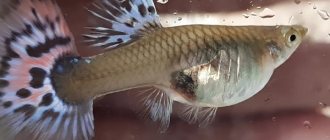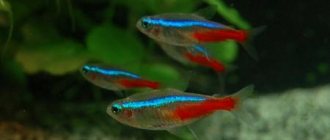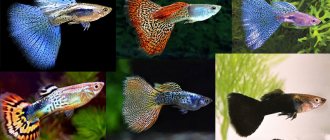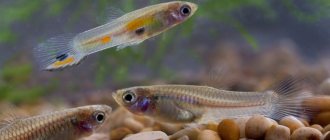Guppy
Guppies are small fish from the poeciliaceae family. They have earned their popularity due to their strong immunity, high survival rate and beauty. But last but not least, a method of reproduction unusual for fish. All types of guppies are viviparous! Yes, yes, during the process of reproduction, fertilization of eggs occurs directly in the female’s body, where she bears it, and then viable, fully formed fry are born. Let's take a closer look at the process of baby guppies' birth to find out the answers to all the interesting questions.
The necessary conditions
Reproduction of guppy fish is a natural process that does not require special human intervention. However, for the best result, it is worth considering a few points:
- Water having a hardness of no more than 15 units, as well as water acidity not exceeding 8.5 Ph.
- The water temperature should be at least 25oC, so the fish move closer faster.
- Maturity of fish.
- Consumption of live food that contains proteins.
The presence of lighting plays an important role - it illuminates the bright tails of males to attract females.
Launch into a community aquarium
When can you safely add fry to adult fish? The answer is simple: as soon as they grow enough to avoid being eaten. Age doesn't really matter. Some individuals can be quite large after two weeks, while others remain tiny at this time. A general rule for all fish, not just guppies: when the fry have grown to 1.5 cm, they are ready for transplanting.
Before global relocation, you need to make sure that the raised babies will survive in a common aquarium. To do this, the tank must have a lot of shelters: plants among which the guips can hide. From among the inhabitants of the aquarium, it is necessary to exclude aggressive and predatory fish, for which small guppies will become tasty prey.
On a note! The fry should be prepared for transplantation gradually: lower the water temperature, bringing the parameters of the fish tank closer to those of the general tank.
How do guppies mate?
You will immediately notice if the fish begin their mating season. During this period of time they move faster than usual. Males actively pursue the female and approach her from the side or below. It is important to take into account that there should be fewer males than females, otherwise the males can drive the female to death. That is, for one male there must be at least 2 females.
Guppy mating itself occurs with the help of a movable anal fin in the form of a tube in the male, which is called “gonopodium”. Fertilization occurs in the female's abdominal cavity, where seminal fluid penetrates. Afterwards, it is stored in the mother’s body for a long time, so the female can be fertilized several more times without the presence of a male.
When to place guppies for birth?
Moving to a new, unfamiliar environment creates a stressful situation for a pregnant female. She may refuse to feed, which leads to loss of strength and loss of health, sometimes even death.
Therefore, the fish should be in the fish tank for a minimum period of time.
If possible, you can purchase a special tray that is attached to the aquarium and allows the pregnant female to remain in her usual habitat and not experience unnecessary stress, which often leads to a delay in childbirth.
You can determine that the time has come to place the female in a separate container for birth by her appearance ( rectangular belly, enlarged black spot ) and behavior.
During this period, males begin to constantly pursue pregnant females, swimming after them in groups and trying to bury their noses under their bellies.
Females try to hide in dense thickets of greenery, lie on the bottom and hide in the darkest and most secluded places.
The optimal capacity for females ready to give birth would be an aquarium with a volume of fifteen to thirty liters.
With smaller sizes, it is difficult to monitor the quality of water, and with larger sizes, after the birth of the fry, difficulties arise with feeding and monitoring them.
There should be no soil in the aquarium. During this period, the cleanliness of the container is of great importance, and the soil complicates the cleansing process.
You can decorate the aquarium with Ricci algae, Java moss and some dense aquatic plants.
also need to install a filter , preferably an internal one with a large filter chamber volume. After this, it is necessary to adjust it to a weak water flow, since a strong current is harmful to the fry. The filter and compressor must operate around the clock.
The fish tank must have a biologically balanced microflora.
Avoiding cannibalism
These aquarium fish, unlike others, lack maternal instinct. Guppies are cannibal fish, so after giving birth, the female can safely eat her offspring. To avoid this situation, after birth it is worth separating the fry from the mother, if the spawning took place in a separate vessel. If spawning took place in an aquarium with other fish, you should provide the fry with places where they can hide from large individuals: add various algae, driftwood, and stones to the aquarium.
With good and sufficient nutrition, you can completely wean guppies from cannibalism.
The fish reach sexual maturity at the age of 4-5 months.
What to do if the female cannot give birth?
In most cases, guppies give birth quite easily, with virtually no problems or complications. But there are situations when a large, old or very young female cannot give birth.
This can be helped by simply raising the water temperature a few degrees. But this needs to be done smoothly, without sudden jumps. A rapid rise in temperature will cause extreme stress and will only make the situation worse.
To stimulate the onset of labor, you can change the volume of water by 20-30% in an aquarium with a pregnant female.
Pregnancy period
Since guppies are viviparous fish, their embryos develop inside the mother. The gestation period ranges from 20-45 days, most often the gestation period lasts a month. How long a guppy's pregnancy will last depends on external factors such as water, nutrition, water temperature, as well as internal ones: the age of the female. So, young fish have a longer lifespan than older fish.
The water temperature has a strong influence: the higher it is, the faster the guppy will give birth. However, if the temperature is too high, there is a high risk of the birth of premature fry, and if the temperature is too low, the fry will be underdeveloped. During pregnancy, it is worth maintaining a stable external environment; you cannot change water in large quantities, otherwise this can lead to stress for the pregnant individual, which in turn can lead to a miscarriage.
Determining pregnancy in guppies
A pregnant guppy can be distinguished from others by several characteristics:
- Behavior. She becomes aggressive towards other fish, does not allow males to approach her, begins to eat more, tries to hide, and seeks solitude.
- Appearance. Her abdomen becomes larger, rounded, closer to childbirth - rectangular and a black spot is visible below. The back bends, the head next to the abdomen seems small, such a sharp change is called a “step”.
In the early stages, especially for beginners, it can be difficult to identify a pregnant guppy, but if you carefully monitor the appearance of these signs, you can easily track the progress of pregnancy.
Is it necessary to remove the female for childbirth?
During pregnancy, it is important to recognize the moment when it is necessary to remove the guppies for childbirth. After the fish has a strong black spot and the anus increases in size, it is worth placing the female in a separate aquarium or placing it in a fish tank (a special tray placed in a common aquarium). In such conditions, she will not feel stressed by the presence of other inhabitants of the common aquarium.
In a separate aquarium, the same conditions should be created, for this you need to fill half with water from a residential aquarium, and fill the other half with fresh water of a similar temperature - this way the female will not feel the changes and will not experience stress.
On a note! The aquarium should be 10-15 liters, without soil, with a variety of plants. However, a three-liter jar with the same conditions may be suitable.
Guppy pregnancy ranges from 20 to 45 days
Behavior before childbirth
Immediately before the birth itself, the female's behavior will change. Before giving birth, the guppy eats little or refuses to eat, often belching food. He doesn’t move much and gets cold, so he looks for a warmer place and often stays near the heater. If the female is left to give birth in a common aquarium, then she will hide on the bottom, hide from other inhabitants, otherwise the males will chase her and push her head into the stomach.
How does childbirth occur?
The owner should know how guppies reproduce at home in order to control the situation. Labor begins when the pregnant guppy freezes and her tail begins to tremble, usually at night or in the morning. Since the guppy carries the fry in the abdomen, during childbirth they swim out one after another, or in small groups, and are distributed throughout the aquarium, hiding so as not to be eaten.
Childbirth lasts from 1 hour to 12 hours. You can speed up this process by gradually adding fresh water and increasing the water temperature by 2-4 degrees. A male can also contribute to the birth; in extreme cases, he can be placed with a pregnant female, but after the onset of labor he should be placed back.
Postnatal behavior of the female
After giving birth, the guppy quickly comes to its senses, its behavior becomes normal: it becomes active, searches for food and can become pregnant again. After giving birth, it should be immediately moved to a common aquarium and separated from the juveniles in order to preserve the offspring. You can divide the container with a lattice, with small holes through which a large individual could not swim, unlike fry. The offspring are born capable of life without a mother, so her presence and attention are not required, all this falls on the shoulders of the owner.
The fry are born quite independent
Postnatal behavior of the female
A female that has just given birth may eat the fry. That is why, after the completion of the birth process, it is worth moving her away. If you are absolutely sure that all the fry have appeared, then the female can be transplanted to the other fish in a common aquarium.
When there are still suspicions that the fish has not yet completely given birth, it is best to place it in a special aquarium with small holes - the fry will freely pass through them, but the adult fish will not be able to get out. Leave it there for a couple of hours. The spawning tank is placed directly inside the spawning tank.
Features of female behavior after childbirth:
- calms down quickly enough;
- becomes active;
- begins to look for food;
- She may soon become pregnant again.
After mating with a male, the guppy is able to bear offspring 8 more times. Therefore, even if the female is removed, she can still give birth to fry again.
Caring for fry
In the first stages of a fry’s life, it is important not only to protect them from being eaten by their mother or other large individuals, but also to provide them with good conditions and high-quality nutrition. This way you will get beautiful and healthy offspring of gupeshka fish.
It is important to monitor the quality of water and enrich it with oxygen using an aerator, and change it often. The fry need dense vegetation, which helps them hide from larger fish. Plants such as hornwort, nayas, elodea, Java moss, pistia, and riccia are often used.
Important! The fry need a balanced diet; any small food is suitable for feeding them.
How many fry can be born
It is impossible to determine the exact number of guppy fry born, as this is influenced by several factors:
- female size;
- number of previous births;
- age of the female;
- conditions of keeping and feeding.
The older, larger and more experienced the fish, the more offspring it will be able to produce. The largest recorded number of fry is 180. It is generally impossible to accurately count the offspring due to cannibalism. The first spawning is characterized by 15-20 fry.
Determination of gender
You can determine the sex of fry after 1-3 months after birth. They acquire their own distinctive characteristics, by which individuals can be easily sorted.
At the age of a month, female guppies develop a characteristic black spot near the anus. It is worth knowing that it appears unevenly in different individuals, so it is worth observing the fry for up to 1.5 months to be sure. When breeding purebred guppies, the females should be placed in a separate aquarium, which will protect them from active males and preserve the necessary characteristics of the breed. Should be kept separately until puberty.
Males are characterized by the appearance of a gonopodium formed from the anal fin. By the time of puberty, males are smaller in size and acquire bright colors, unlike females.
The mother must be removed from the nursery after giving birth
The first days of the fry
The fry are born already formed, their length on average is at least 5 mm. After birth, the fry swim to the top to take a breath of air that will fill their swim bladder, and then dive to the bottom and hide. The first five days of juveniles require a lot of attention and special conditions. The water temperature should be kept at 28 degrees and after 3 days gradually reduced to 24. The water should be changed periodically, 30-40% of the entire container.
Note! In the first week, you need to keep the aquarium illuminated around the clock, which will contribute to the rapid growth of the fry. You need to put a filter in the aquarium and get rid of the soil that will interfere with the purification of the water.
At first, feeding is carried out all day: the full daily food intake is divided into 6 meals. And after 1-2 weeks it is worth reducing the number of meals to 3 times.
What to feed the fry
Live dust, rotifers, and microworms are usually used for food. You can also feed boiled, pureed and diluted chicken yolk in water. Special feeds are produced on a large scale that are suitable specifically for fry. And starting from the second week of life, they are gradually transferred to adult food.
Well-balanced and high-quality food will enable the fry to quickly grow up to 2 centimeters in length. At this size, they can already be transplanted into a common aquarium. This will also affect their color, making it brighter and more interesting. It is important not to overfeed the fish, and also not to pollute the water with food. To avoid this, you can use dry daphnia powder as food, which will remain on the surface of the water and be easily collected by the fish.
For the first feeding, only live food is used
How long do fry grow?
Depending on the care, quality of conditions and feeding, the period of maturation and formation of the fry will increase or decrease. If all the rules are followed, the fry will develop into large fish within 3-5 months. Then they themselves can give birth to their offspring. It is important to separate females from males at puberty to avoid early pregnancy and later sickly offspring.
It is important to take into account and monitor the fry, since their growth is individual, it is necessary to separate the already grown individual from the rest in time in order to protect them.
Attention! When the fry reaches 1.5-2 centimeters, it can be transplanted; it will not be food for large guppies.
How to preserve offspring?
The problem of how to care for fry after birth ranks first among beginners' questions. Reproduction of fish will bring pleasure only if you manage to raise the resulting young fish. The most difficult thing is to understand what to feed the fry in the first days. In order for them to grow faster and develop properly, feeding begins from the first day. It is better to take care of food in advance:
- purchase ready-made starter feed in the store;
- breed food organisms yourself;
- Keep the aquarium with the fry in the light so that green algae grows on the walls.
The fry receive everything that is necessary for the growth of young fish with food. Experienced breeders who take care of the selectively bred offspring they need, raise ciliates to feed the fry.
This food is sold under the name live dust. The water containing the microscopic creatures is pipetted into the spawning tank. At first, the fry are able to eat only such small food and algae from the walls of the aquarium. As they grow, the fry's diet includes live crustaceans:
- Artemia nauplii;
- daphnia;
- Cyclops.
In addition to live fish, they are also given concentrated food for fry (colored flakes). Growing fish are fed increasingly larger foods (tubifex, scraped meat, granulated concentrates). The size, richness of color, and good appearance of adults depend on how to feed the fry at an early age.
Care and maintenance of fry
Caring for the fry also includes maintaining a favorable environment in an artificial reservoir. To correct the temperature, a water heater with a thermostat is used. To saturate the water with oxygen, turn on the aerator. The nursery aquarium must have a filter.
In addition to technical devices, the owner must also take care of the quality of water. 1-2 times a week, the bottom is cleaned with a siphon, collecting waste from the juveniles. When cleaning, be careful not to get fish into the siphon. After cleaning, with which 1/3 of the liquid volume is drained from the aquarium, fill it to the previous level with clean, settled water.
Determining the sex of the fry
Another important question is how to determine the sex of born fish, how to understand who is more numerous in the school. Young fish look the same, and become different at the age of 2-3 months. They are already large enough for the owner to see the gonopodium of males. The color and size of the tail of males are also sexual characteristics, but modern breeds, which even beginners prefer to raise, often do not have pronounced differences.
When the sex is determined, it is advisable to separate the young females from the males and raise them separately. If you are not engaged in selective breeding, plant the young animals in a common acarium as a whole flock.
Recommendations for proper breeding of guppies
For beginners, guppies are a suitable breed of fish, as they do not require special care and conditions. However, to breed beautiful and healthy offspring, it is important to know the basic rules for breeding fish at home. Sometimes there are situations in which guppies do not reproduce or, on the contrary, often reproduce. Then it is important to understand what the problem is and quickly eliminate it in order to achieve a solution to the issue. Often simply observing the behavior of the fish will help the owner understand and solve the problem. Then watching fish becomes not only a calming, but also an educational activity.
For successful reproduction, it is necessary to monitor the cleanliness and quality of water.
Why don't guppies reproduce?
Aquarium guppies are very prolific, so when reproduction does not occur within 1-2 months, it is worth considering. Reasons for this situation:
- All fish in the aquarium are same-sex.
- The female is pregnant, but does not yet show the first signs or they are not noticeable to the owner.
- Guppies reproduce, but are quickly eaten by their mother or other fish.
- The fish are stressed due to overpopulation and are therefore unable to reproduce.
- The female's body is not ready for fertilization, as it does not receive enough food.
- The water does not change for a long time. There is no increase in water temperature that could promote reproduction.
- Overfeeding your fish is just as bad as starving them. Obesity of internal organs prevents reproduction.
How often do guppies give birth?
Guppy fish give birth once every 2 months. To avoid overpopulation, you can separate the females from the males. However, this may also have no effect, since the female guppy can still give birth for months without a male. In this case, you can not make any efforts during pregnancy and let the female eat the fry.
What else is important to know?
Guppies are very beautiful and viviparous aquarium fish. There are practically no problems with their reproduction. But in order to regularly produce strong and healthy offspring, they need to be provided with optimal conditions.
Puberty
Females quickly become ready for pregnancy. Full puberty occurs at approximately 2-3 months of age. This is the optimal period when the female is ready for fertilization and can produce strong offspring.
Spawning, aquarium preparation
Guppies do not require any special conditions. To stimulate spawning, it is enough to slightly raise the temperature or refresh the water in the aquarium by adding fresh water.
To reproduce guppies, one male and 3-5 females are enough.
An aquarium with a lot of greenery must be prepared for the fry, where they can hide. Inbreeding should not be allowed, as the offspring may develop various pathologies and external defects. Therefore, guppies need to be bred with special attention.
Fry
There are some characteristics of young offspring that are worth knowing. Namely:
- guppies are born very small and difficult to see, as they have a grayish and translucent color;
- the fry are transplanted into a common aquarium after they have grown a little, so that other fish do not eat them;
- the fry grow actively and at the age of 30-40 days acquire an “adult” coloration; at this age they can be transplanted from the spawning tank to a larger container;
- feed the young animals small food so that they can swallow it.
Reviews
Guppies are beautiful and unpretentious aquarium fish; it is a pleasure to breed them and watch them. With proper and successful breeding of guppies, it is possible to carry out selection work, obtaining specimens of a pure breed with an interesting color and original hybrids by crossing with other species. But if you want such results, you need to understand how they reproduce and monitor it. Responsibility for overpopulation or death of fish lies entirely on the shoulders of the owner. By the way, their health also needs to be carefully monitored, because guppies do not always tolerate diseases well, but this is a topic for another article.
Would you like to buy a Guppy for your own aquarium? Share in the comments!
How does childbirth occur?
Childbirth in a female gupeshka begins with the spawning of babies; their number can vary and depends on many factors. These include the conditions of keeping the fish, hereditary factors, and the health of the fish. Before giving birth, the female guppy becomes somewhat more restless than at other times and begins to actively move around the aquarium, in this process you can see how she throws fry. There can be from a few pieces to hundreds. On average, a guppy gives birth to 30-40 fry. The first spawning usually brings the birth of a small number of fry, from 10 to 20. In subsequent spawnings there will be more, and after a year or two their number will also decrease.
Video: guppy birth
More than 2 weeks
Place males in a community aquarium: the fish are capable of reproduction.
Add additional food (yolk, cottage cheese, milk, vegetables, herbs) and crushed dry food to the diet of daphnia. Feed 3-4 times a day.
View this post on Instagram
Baby #guppies eating cucumber?? . #fish #aquarium #aquarium science #aqua #aquarium fish #guppy fry #fry #babies #feeding #my aquarium #fish breeding #pets
A post shared by Alice and company (@boba_co) on Sep 7, 2021 at 7:16am PDT
More than a month - add chopped bloodworms, coretra, and tubifex to the diet. Lighting 8–10 hours. Water temperature - 27 °C. Changing water and cleaning the bottom - 2-3 times a week.
Selection
Work on breeding a specific breed requires careful selection of individuals. If there are guppies of different colors and shades in the aquarium, then selection work will not bring results.
In order for breeding at home to be successful, it is first of all necessary to maintain favorable conditions in the aquarium. High water temperature will lead to infertility, and low water temperature can cause illness and death of fish.
For selection, individuals are selected who have never taken part in sexual intercourse before. From a young age, guppies are sorted by gender, size, color and age. If the selection strategy is thought out at the selection stage, then the desired result can be obtained.
Blue neon guppy is the fruit of a breeder’s long and painstaking work.
One pair of producers is placed in three tanks. When the offspring from these pairs reaches puberty, they are crossed with each other in the following sequence: a girl from the first pair is crossed with a boy from the third pair, a girl from the third pair is crossed with a boy from the second. This avoids connections between relatives. As a result of incest, fry appear with defects in physical development, and their offspring lose their bright coloring. As a result of incest, small individuals are obtained.
Buying fish from different regions will help to avoid inbreeding during selection.
Guppies are aquarium fish that do not require special care or conditions. But if their numbers are not controlled, the number of individuals will quickly become excessive, and this will lead to the development of various diseases, as well as the death of the population.
Types of food
Guppy fry need live and plant food. Store-bought dry ones contain everything you need, including vitamins.
Commercial feed
Ichthyologists and ichthyopathologists recommend Tetra, Sera, JBL powders.
For fry up to 1 cm long:
- Tetra MicroMin.
- Sera micropan.
- Sera micron.
- JBL NovoTom.
Tetra BioMin paste.
Natural feed
Guppies are omnivores, but the fry need protein for active growth. Protein is abundant in live food. The food is mobile, which awakens the hunting instinct in the fish. Does not spoil water.
In the first days, use home-grown food.
- "Living dust" - ciliate slipper. Size - 0.15–0.25 mm.
- Nauplia is the larva of Artemia. 0.4–0.6 mm in length. It is not used for continuous feeding due to the risk of obesity in the fry.
- Microworm - round worm, nematode. Dimensions: 0.05–1.5 x 0.05 mm. High-calorie replacement for nauplii.
- Phytoplankton are microscopic algae that are harmful to the aquarium through water blooms and are important for the diet of fry. Place the jar of aquarium water in sunlight. In a couple of days algae will appear. Use a medical syringe to place it in the aquarium.
Live food from natural bodies of water is dangerous. There is a possibility of fish poisoning, parasites and infection. Ozone disinfection will help, but it will not get rid of toxins.
Daphnia, also known as "water flea". Size from 0.15 mm depending on age and type. High protein content. There are vitamins and microelements. Lives in natural reservoirs.
Mosquito larvae and worms are fed to the fry, crushed.
Bloodworm, also known as “raspberry” because of its deep red color. Size 5–20 mm. Nutritious, but chopped spoils the water. When purchasing, pay attention to the color. Pale - young, with a minimum of nutrients. With a brown tint - old, hard, cannot be stored for long. Do not let the fish get any dead bloodworms - they will be poisoned.
Koretra is a transparent mosquito larva. 6–10 mm in length. A predator, it does not obtain food at the bottom. Therefore, in terms of infection and poisoning, it is not as dangerous as bloodworms. Low protein, not suitable for constant feeding.
The tubifex is a thread-like worm of pink color with a brown tint. Length - up to 40 mm. In nature, it lives at the bottom of silted, dirty reservoirs. High in calories, not recommended for long-term nutrition due to fish obesity.
- Useful for the growth of fry and weakened adults.
- It is enriched with vitamins if placed in a prepared solution: 250 mg of multivitamins per 100 g of tubifex.
- The most dangerous are infections and parasites, intoxication. Before feeding, a period of at least 5 days is required to remove food residues.
Specimens 1–1.5 mm in size are generally suitable for fry. Separate with a strong stream of water. The tubifex clump falls apart. Large worms sink, food for fry floats.
Frozen food is not as dangerous. But not all harmful contents are frozen; the chemical composition does not change. The quality of the raw materials is unknown. A conscientious manufacturer cannot guarantee proper handling during transportation and storage.
Live food substitutes
It is impossible to completely replace live food. Not processed, nutritious, mobile. Partly - purchased dry food, dry daphnia.
- Crushed hard-boiled chicken egg yolk. Before feeding, grind and add aquarium water. Squeeze into a container through cheesecloth.
- Milk powder. To prepare it yourself, evaporate the milk in a water bath.
- Cottage cheese. Heat the curdled milk until a lump forms - cottage cheese. Rinse the cottage cheese and squeeze it into the aquarium through cheesecloth.
- Cereals. Crushed oats (flakes), corn, semolina.
- Chopped vegetables, herbs.
You cannot feed the fry with substitutes alone. Use as a dietary supplement. Uneaten leftovers spoil the water, which can lead to fish poisoning. Remove using a siphon.
Why don't the fry grow?
- If the fish are purchased, the change in conditions affects them. Difficulties with couple compatibility.
- Overcrowding of the aquarium. Choose a volume based on 0.4–0.5 liters of water per fry.
- Water quality. Lack of ventilation, filtration, irregular water changes and waste disposal are fraught with nitrate poisoning.
- Not a varied diet, not enough live food, not enough protein, overfeeding.
- Stress in a female on the eve of childbirth. Premature birth.
Guppies are unpretentious, but not juveniles. Proper nutrition of the fry in the first days after birth is important. Varied, frequent, dosed. Clean, fresh water. Temperature regime. Without proper maintenance, the fry will not reach normal size. The color of the body and fins is spoiled.
Previous
Fishes24 predatory fish for the aquarium
Next
FishFeatures of keeping a glowing aquarium fish neon
How are fish born in order?
To a greater extent, fish reproduce by laying eggs (spawn). And from the fertilized eggs, larvae hatch, which at first do not look at all like adult fish - there are no fins, the head and tail are of a peculiar shape. The larvae are inactive and often hide between underwater plants.
Interesting materials:
How to find out whether Outbid or not? How can I find out from a receipt what was purchased? How to find out the email to which your Apple ID is linked? How can I find out where I am assigned to a hospital? How to find out the processor bit size in the BIOS? How to find out the Reg Code of a watch? How to find out the cost of production? How to find out the serial number of a remote computer? How to tell if a rib is broken or not? How to find out the daily air temperature?
